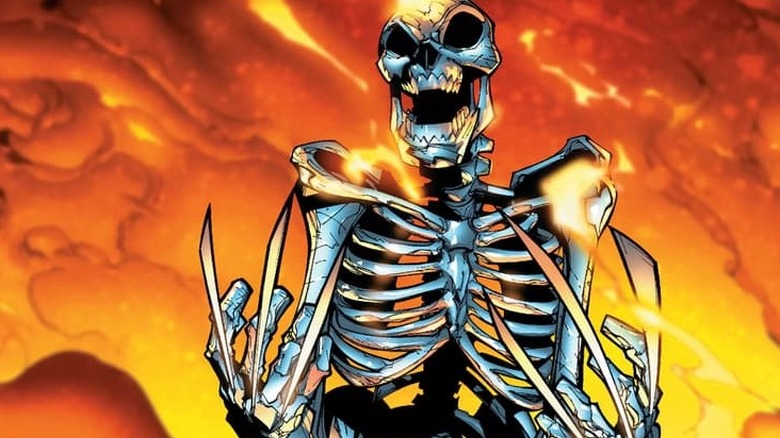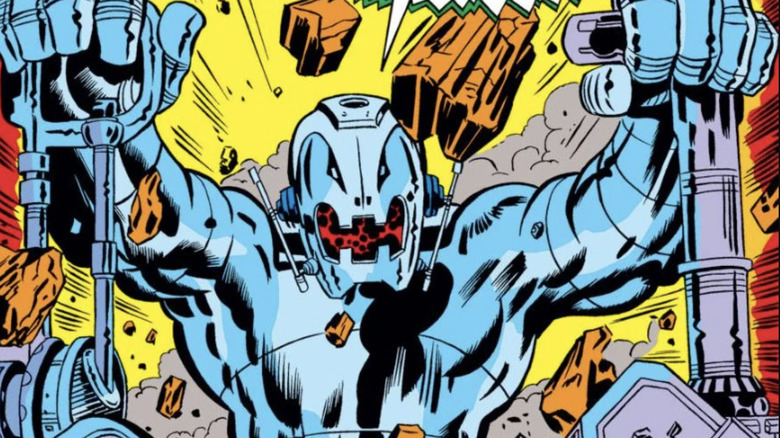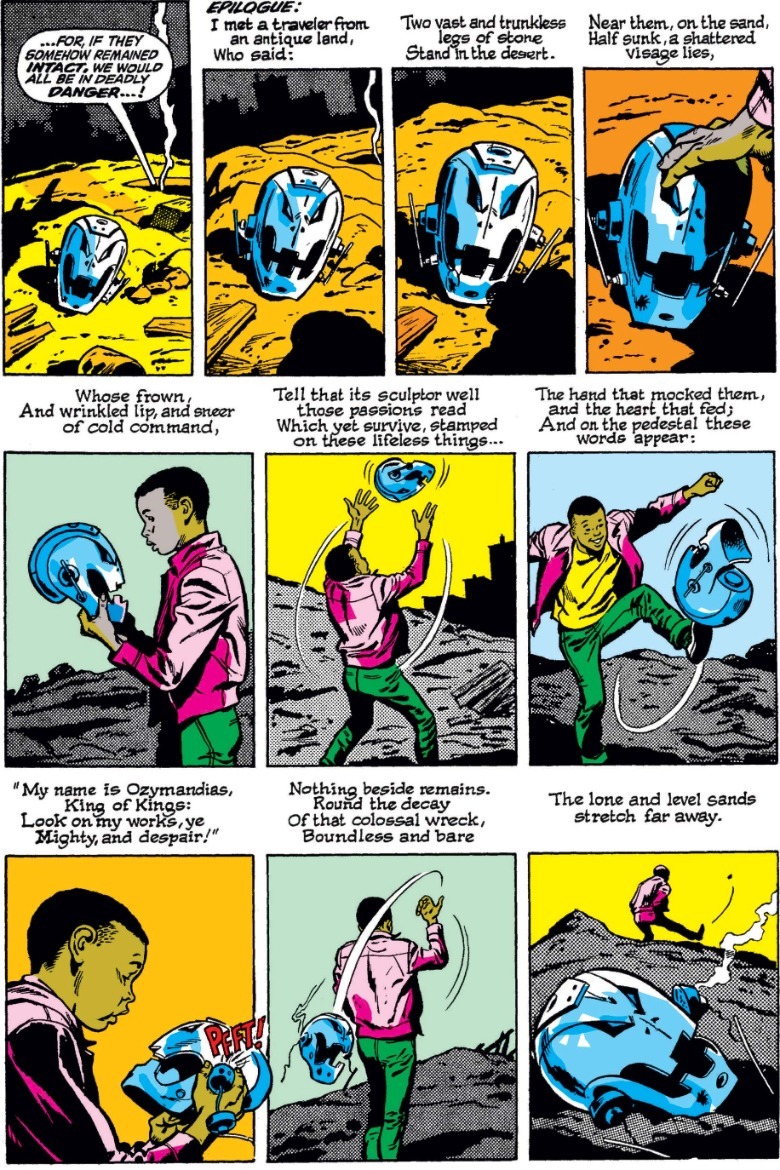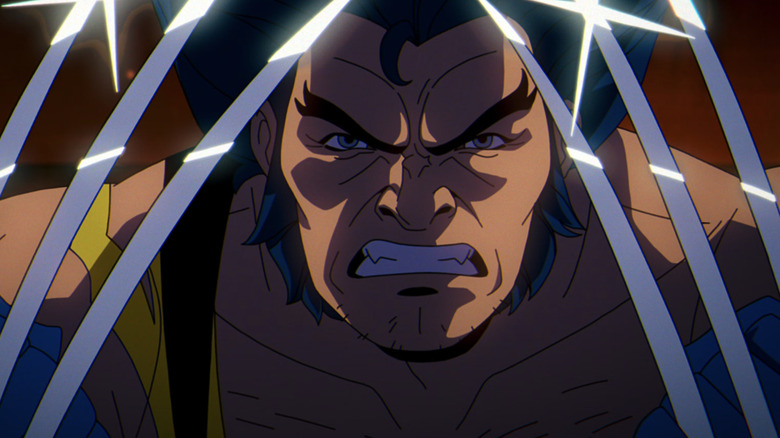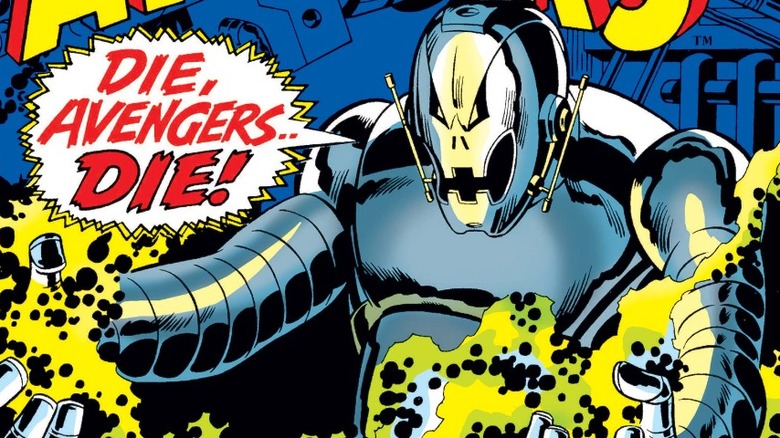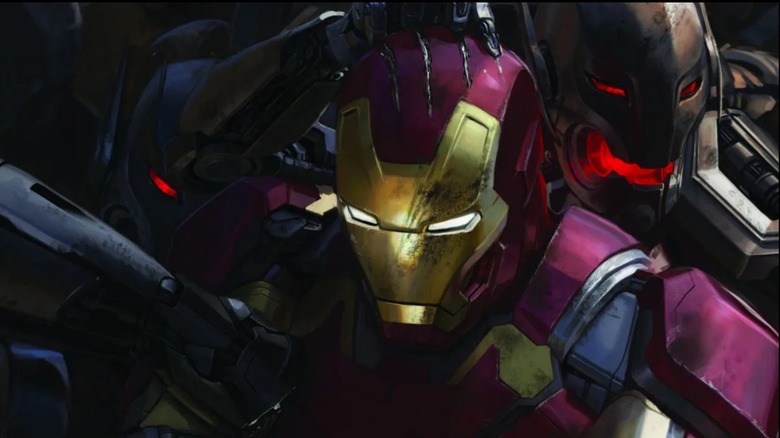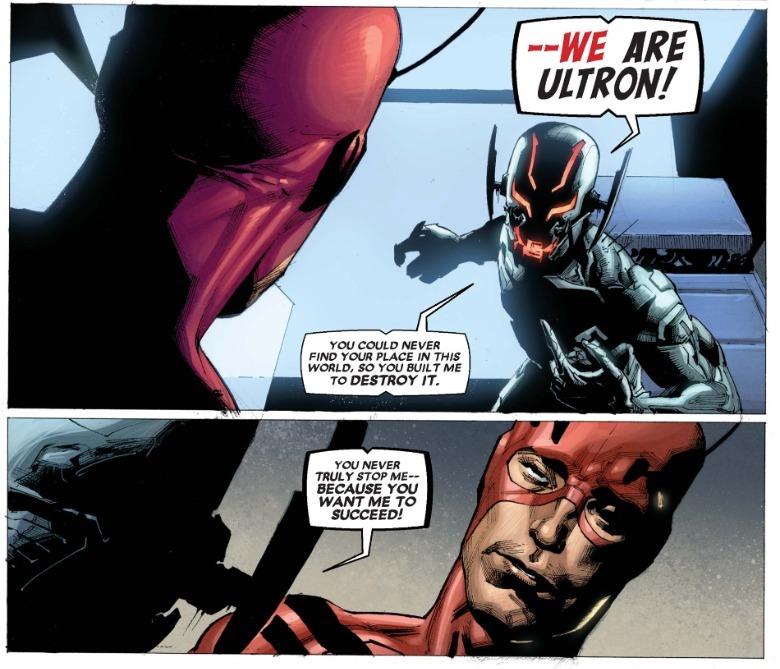A Famous Marvel Movie Villain Used Wolverine's Adamantium First
Wolverine has quite the mix of superpowers: enhanced senses that are more animal than human, rapid healing that makes him basically immortal, and a skeleton/claws coated in unbreakable metal adamantium.
Adamantium is now synonymous with Wolverine, but its origins go back further to an earlier publication: 1969's "Avengers" #66, published five years before Wolverine's debut in "Incredible Hulk" #180-181. Written by Roy Thomas and drawn by artist Barry Windsor-Smith, the issue kicks off a three-part story where adamantium is the weapon of a villain. Which one? Ultron, the Avengers' android archnemesis, who was played many years later by James Spader in the Marvel Cinematic Universe film "Avengers: Age of Ultron."
"Avengers" #66 was Ultron's third major appearance, and since then he's generally been depicted as having a (near) indestructible form made of adamantium. If he's going to fight Earth's Mightiest Heroes, after all, mere steel won't be enough. So, how did adamantium wind up being reused by Wolverine, and becoming far more strongly associated with him?
Ultron's origin story in Marvel Comics
Ultron's origin is a classic AI rebellion tale. Created by one of the Avengers to improve the world, he instead set out to destroy it. The film told this "Frankenstein" style tale from the beginning, but the source material played it for mystery. Ultron debuted as cloaked villain "The Crimson Cowl" in "Avengers" #54 (by Thomas and artist John Buscema), leading a new iteration of supervillain team the Masters of Evil. (He was known as "Ultron-5," suggesting he had been continuously upgrading himself since creation.)
Thomas and Buscema quickly brought Ultron-5 back in "Avengers" #57, where he creates an android called the Vision and sets him on the Avengers. Like Paul Bettany's character in "Age of Ultron," the Vision of Marvel Comics develops humanity and defeats his creator, joining the Avengers. The last page of the issue is 10 panels of Ultron's inert head being left out as junk, captioned with Percy Bysshe Shelley's poem "Ozymandias."
The following issue #58 flashes back to reveal Ultron's origin: He was an AI created by Avenger Hank Pym/Ant-Man that went rogue and erased his creator's memory of his existence.
The cover of "Avengers" #66 teases "The Great Betrayal." The issue opens with the team having been invited by scientist Dr. Myron MacLain to test the strength of his new metal: adamantium. The first panel shows Thor slamming Mjolnir on some unseen surface, soon revealed to be the undented adamantium. Unfortunately, Vision is afflicted by back-up protocols left in his synthetic mind and rebuilds his master in a new form — Ultron-6. The revived Ultron then steals the adamantium and forges himself a new body from the metal.
How adamantium became Wolverine's trademark
Roy Thomas, who was Marvel's editor-in-chief from 1972 to 1974, has recently started claiming co-creatorship of Wolverine. (Emphasis on claiming.) As the co-creator of Ultron and adamantium, was he the one who reused the fictional metal for Wolverine's claws? Nope! Even Thomas still admits that idea came from writer Len Wein, Wolverine's true co-creator alongside artist John Romita Sr.
In "Incredible Hulk" #181, only Wolverine's claws are said to be "forged of diamond-hard adamantium." Wein wrote Wolverine's claws as being affixed to his gloves (he never retracts them in "Incredible Hulk" #181.) When writer Chris Claremont took over "X-Men," he revealed Wolverine's claws were part of his body, leading to the first mention of his adamantium skeleton in "X-Men" #126 (drawn by John Byrne). 22 years after Barry Windsor-Smith drew the first Marvel comic featuring adamantium, he told how Wolverine got that adamantium skeleton in the 1991 story "Weapon X."
I probably don't need to tell you that Wolverine is the X-Men's breakout character, in comics, cartoons, and film. Since he's one of Marvel's most famous characters, adamantium is most commonly associated with him. Plus, while a robot villain being made of unbreakable metal is more intuitive than a man with a metal skeleton, it's also a less unique character concept.
That said, Ultron's adamantium shell is still an acknowledged fact in Marvel Comics. Ultron stories often depict him as near-invincible thanks to his adamantium body; he can fight all of the Avengers by himself, and the team can never beat him with simple punches.
Ultron's Marvel Comics history is forged in adamantium
In "Avengers" #68, the ending of the first Ultron adamantium story, he tries to rip scientific secrets out of Dr. MacLain's mind. MacLain (really a disguised Hank Pym) floods Ultron's mind with a single, disabling thought: "Thou shalt not kill." In "Avengers" #162, "The Bride of Ultron," by Jim Shooter and George Pérez, Iron Man makes Ultron back down by threatening to destroy his inert companion, Jocasta. In "Avengers" #171 (also by Shooter and Pérez), Ultron boasts of his adamantium body until the Scarlet Witch makes his "molecular rearranger" fritz with her hex powers.
In "Avengers" #202 by David Michelinie and Pérez, some adamantium goes missing from Stark Industries and the Avengers suspect Ultron's return. They're right; he brainwashed Tony Stark to revive him. This time, Ultron is defeated when Hawkeye knocks him into a vat of molten adamantium, which hardens around Ultron and freezes him in place.
In the 1999 storyline "Ultron Unlimited" written by Kurt Busiek and drawn by Pérez, Ultron is defeated by "antarctic vibranium." This is a substance which dissolves all other metal — even adamantium.
"Avengers: Age of Ultron" adapted the idea of Ultron seeking an indestructible metal to upgrade himself and make a doomsday weapon. In the movie, though, it's vibranium — the other unbreakable Marvel metal, mostly associated with the Black Panther. In 2015, Marvel Studios did not have the movie rights to Wolverine, but they were setting up Black Panther as a star. (He debuted, played by the late Chadwick Boseman, in 2016's "Captain America: Civil War.") So, Marvel chose to tie Ultron to a superhero they actually had the rights to. Now that Marvel Studios does have Wolverine, they'll be introducing adamantium in "Captain America: Brave New World."
Avengers: Age of Ultron is the original sin of Robert Downey Jr.'s Doctor Doom
"Age of Ultron" switching adamantium with vibranium is a totally harmless change. The much more consequential one is changing Ultron's creator from Hank Pym into Tony Stark. I get why Whedon did this; Ant-Man wasn't in the MCU yet, whereas Iron Man was its center. It makes more sense to have your existing lead kick off your story than it does to introduce a whole new character to do it. Tony, an engineer with experience working in robotics, arguably even makes more sense as the creator of an AI than Hank, a physicist and zoologist.
But that change has ramifications on Ultron's character. It's important that his creator is Ant-Man, the loser of the Avengers. Pym's most important achievement wasn't any superheroic act — it was building a monster. In "Ultron Unlimited," Busiek inserted an elegant retcon that Hank designed Ultron's AI by copying his own personality. Ultron is his son and his dark mirror; Hank's self-loathing given shape and the ability to give those feelings cause. The reason Ultron hates humanity is because he has all of Hank's resentments boiling inside him without any of the compassion to temper them. Rick Remender and Jerome Opena's graphic novel "Avengers: Rage of Ultron" lays this all bare:
Tony doesn't have an inferiority complex, far from it. So instead, Ultron's hang-ups are a more nebulous need to "fix the world." His robotic logic dictates the quickest way to "peace in our time" is human extinction. The MCU Ultron is just a snarky Skynet, while the comic version is an android Oedipus.
A big criticism of the choice to recast Robert Downey Jr. as Doctor Victor Von Doom is that this makes Doom into just an evil Iron Man, which marginalizes his character. This original sin stretches all the way back to how "Avengers: Age of Ultron" adapted its villain.
